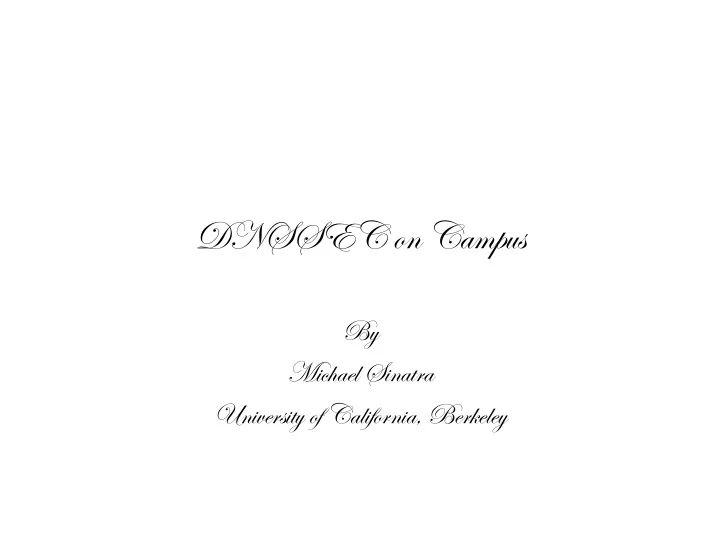

DNSSEC on Campus By Michael Sinatra University of California, Berkeley
•You didn’t think I was really going to use that font, did you?
What we did •Began validating DNSSEC responses on our caching resolvers using ISC DLV in October 2008 •Participated in EDUCAUSE EDU testbed, Fall 2009 •Began signing berkeley.edu and most subzones, plus in-addr.arpas in January 2010. Have not yet placed our keys in any DLV or TAR
Why do it? •Yes there is risk: – Research universities should still be willing to be on the bleeding edge. – Risk should be reasonable. – There is recognition at UC Berkeley that we have had a role in the development of the Internet and we shouldn’t (have) abandon(ed) that role.
DLV: How’d it go? •Surprisingly well. •Three failures in 16 months. – GOV NSEC3 validation •This was a BIND (<9.6.0) coding issue (now fixed). unbound already supports NSEC3. – Signing issues (the first one was a doozy) •(didn’t get too much flak, though) •This is a basic DNSSEC issue, not a DLV issue
DLV: How’d it go? •The irony is that early validators may have had an easier time of it. •Now that GOV agencies are under the gun to “sign- baby-sign,” we’re seeing a number of issues, and sometimes we’re paying for it.
EDU testbed •UCB participated beginning in September 2009. •Created our own testbed. •Published keys in EDU testbed and created stub zones for testbed EDU zone to allow test resolvers to validate. •Worked well and we learned a lot.
EDU testbed • What did we learn – Signing is not as hard as I feared, but it is tricky. – If your signatures expire (usually because you don’t re-sign your zone periodically), your zone WILL BREAK. – Serial number manipulation can be tricky, especially when you already have one process and your signing tools assume a different process. – ZSK rollover isn’t so bad, but KSK rollover can be tricky. – Algorithm rollovers (e.g. RSASHA1 to DSA or RSASHA1 to RSASHA512) are even trickier. •MUST have KSKs and ZSKs for both algorithms (RFC 4035)⋯ •⋯but implementations handle incomplete algorithm pairs differently!
Signing berkeley.edu • For real – We had a two week campus-wide furlough/shutdown and it was too hard to pass up. – Decided to get the signed zones into the authoritative servers but not publish the trust anchor in any TAR or DLV. •Wanted to test effects of much larger responses •Worried about firewalls and the like •Wanted to give myself some leeway will I tweaked my automated signing processes, in case I occasionally screwed sigs up. •More time to test! – UCB already had an automated signing process, so need to modify that for DNSSEC. – Did it for the testbed, now had to modify it for production.
Signing berkeley.edu • For real – Had to warn campus! •http://ls.berkeley.edu/mail/micronet/2009/1520.html •http://net.berkeley.edu/DNS/dnssec.html – You will want to do this! – Also, let your secondaries know and make sure that they support DNSSEC. Don’t learn nrc.gov’s lesson the hard way!
Signing berkeley.edu • Signed zones were populated into authoritative servers between 1-3 January 2010. – Didn’t want to mess anything up for end-of-year giving. – Populated gradually to make sure that secondaries (U. Oregon, SNS@ISC) could handle. (Didn’t doubt it, but did want to verify.) • Once all auth servers had the signed zones, I worried about firewalls. – Created ‘sacrificial lamb’. options { … minimal-responses yes; // only send answer max-udp-size 512; // EDNS0 responses limited to 512B … };
Signing berkeley.edu • Caused NSes that were sending DO (w/EDNS0) but weren’t getting responses back to eventually fall over to sacrificial lamb • Even got a security/abuse report! 2010-01-14 09:13:54 - Big Bomb - Source:128.32.136.6,0,WAN - Destination:1xx.xxx.xxx.xx,0,LAN Real IP address was included, so was able to correlate this with logs: • 13-Jan-2010 15:13:54.434 client 1xx.xxx.xxx.xxx#1025: query: www.lib.berkeley.edu IN A -ED (128.32.136.6) Client hit sacrificial lamb about a second later, and didn’t query any other auth • servers. Looks like it worked! Found many other cases of queriers bouncing around our auth servers and • then querying sacrificial lamb. Some also disabled EDNS0. (More to discuss in BoF.) •
Signing berkeley.edu • Queries to sacrificial lamb (bindgraph):
Signing berkeley.edu • Memory footprint for an authoritative server:
Signing berkeley.edu • Memory footprint for a caching server:
Signing berkeley.edu • CPU utilization for a caching server:
Signing berkeley.edu • Current status: – Zones are being signed every night, and I have not experienced any validation problems (yet). – Haven’t published KSK in any TAR or DLV; may wait until EDU is signed.
Lessons/Concludatory remarks • Memory/CPU requirements are bigger, but well within today’s capacities. – Signing is on an old machine and it takes about 30-45 minutes to sign 607 zones of varying sizes. – Basically, it has taken us so long to deploy DNSSEC that the hardware has caught up! • Lot’s of stuff to go wrong. – Test, test, test – Monitor, monitor, monitor • Outside of my control (not totally) – Bugs, implementation issues. – Standards under-specify use of KSKs and ZSKs; implementations deal with operational practices differently. • More things to do: – Use smokeping DNS probes at validating and non-validating servers for important zones to make sure validation is working. – Better key management for DR and backup. – Use FreeBSD jails on masters and put keys outside of the jail where named runs.
Thanks to⋯ • Internet Systems Consortium – Paul Vixie, Mark Andrews, Michael Graff, Keith Mitchell, Peter Losher • EDUCAUSE – Becky Granger • Verisign – Dave Blacka, Matt Larson, David Smith, others⋯ • UC Berkeley – Jim Blair, Paul Fisher (E-mail), (ex-) Network Services Group • Internet2 DNSSEC working group – Everyone, especially Shumon Huque, Casey Deccio, Joe St. Sauver, Scott Rose, Steve Crocker, many others • Others: – Olaf Kolkman
The End
Recommend
More recommend